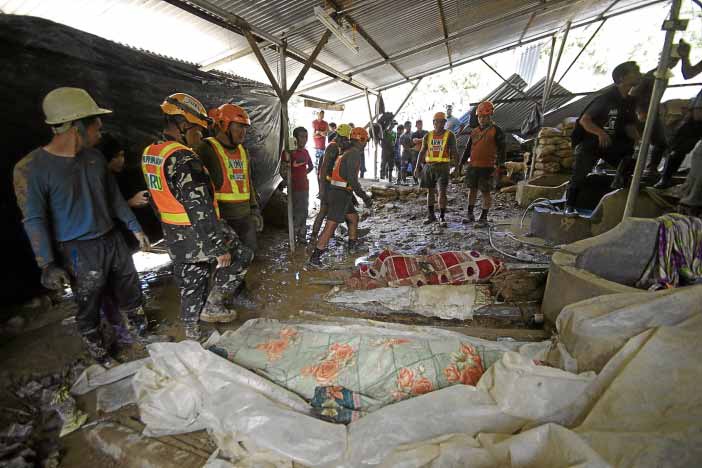
DEAD MINERS Rescuers recover the bodies of three people after a landslide brought by Typhoon “Ompong” buried a small-scale mining site in Itogon town, Benguet province, on Saturday. —RICHARD BALONGLONG
The death toll from Typhoon “Ompong” rose to 74 and damage to agriculture climbed to P14.27 billion as of Tuesday, according to the Philippine National Police and the Department of Agriculture (DA).
Ompong (international name: Mangkhut), this year’s most powerful storm so far, smashed homes and flooded key agricultural regions in northern Philippines on Saturday before battering Hong Kong and southern China with fierce winds and heavy rain.
As of Tuesday, the PNP had received reports about 203 casualties — 74 dead, 55 missing and 74 injured — in Ilocos, Cagayan Valley, Cordillera Administration Region, Central Luzon and Metro Manila.
Most of the casualties — 60 dead, 52 missing and 42 injured — were reported in the Cordillera Administrative Region, a gold-mining area that saw dozens of landslides.
Police said the number of fatalities was expected to rise.
Up to 40 people are still feared buried in the landslide in Itogon, Benguet province, where Ompong stalled and dumped a month’s volume of rain in a matter of hours.
Soil starting to harden
Because the landslide destroyed roads, authorities have been unable to bring heavy equipment into the area to accelerate the search.
As a result the teams were using human chains to extract debris.
The effort was getting progressively more difficult because the rain-soaked soil had started to harden in the scorching sun. Crews were using water to try to soften up the soil.
The area was primed for disaster before Ompong hit, as the landslide came on the heels of nearly a month of continuous monsoon rains that left the already hazardous area soggy and dangerously loose.
List on white board
Many of those buried in Itogon were small-scale gold miners and members of their families who had taken refuge in a building abandoned by a large mining company.
Tearful families surrounded a white board bearing names of the dead and missing as others inspected recovered bodies in an attempt to identify their loved ones.
President Rodrigo Duterte on Monday night met with the families of some victims in Itogon. He distributed P25,000 worth of relief goods and burial assistance.
The Department of Labor and Employment has set aside over P44 million for an emergency employment program for those affected by Ompong in Cagayan Valley.
The labor department said it would give each affected resident P3,450 in exchange for 10 days of work, which includes clearing debris and repairing infrastructure.
Farm losses
Across northern Luzon, farms were flattened and flooded, with the authorities saying crop losses had risen to more than P14 billion.
That could add to inflation woes and worsen a spike in rice prices that has hit the poor hard.
Rice registered P8.97 billion in losses. A total of 435,997 metric tons were destroyed, equivalent to the country’s rice consumption for nine days, according to the DA.
As for corn, damage was placed at P4.50 billion, equivalent to 281,039 MT.
Losses in high-value crops and livestock were placed at P788.13 million and P5.51 million, respectively.
Damage to the fisheries sector was estimated at P24 million.
Damage to universities
Initial assessment showed that 12 state universities and colleges (SUCs) in Ilocos, Cagayan Valley and Cordillera Administrative Region suffered more than P428.8 million worth of damage.
The Commission on Higher Education (CHEd) officer in charge, J. Prospero de Vera III, said on Tuesday that initial reports mostly focused on damage to infrastructure.
Six SUCs in Ilocos suffered over P193.4 million worth of damage, with Mariano Marcos State University topping the list at P86 million.
Other damaged schools were Don Mariano Marcos Memorial State University, North Luzon Philippines State College, University of Northern Philippines, Pangasinan State University and Ilocos Sur Polytechnic State College.
De Vera said officials of Cagayan State University reported that almost all of the school campuses sustained damage, estimated at P215.3 million. Bearing the brunt were its Piat and Lal-lo campuses.
The typhoon also destroyed over P20 million worth of infrastructure in schools in the Cordillera Administrative Region. Destruction was recorded in Abra State Institute of Science and Technology, Kalinga State University, Apayao State College, Mountain Province State Polytechnic College and Ifugao State University.
The CHEd said it had not yet received an assessment report from Benguet State University. —Reports from AFP, Jaymee T. Gamil, Karl R. Ocampo, Jhesset O. Enano, Julie M. Aurelio and Jovic Yee